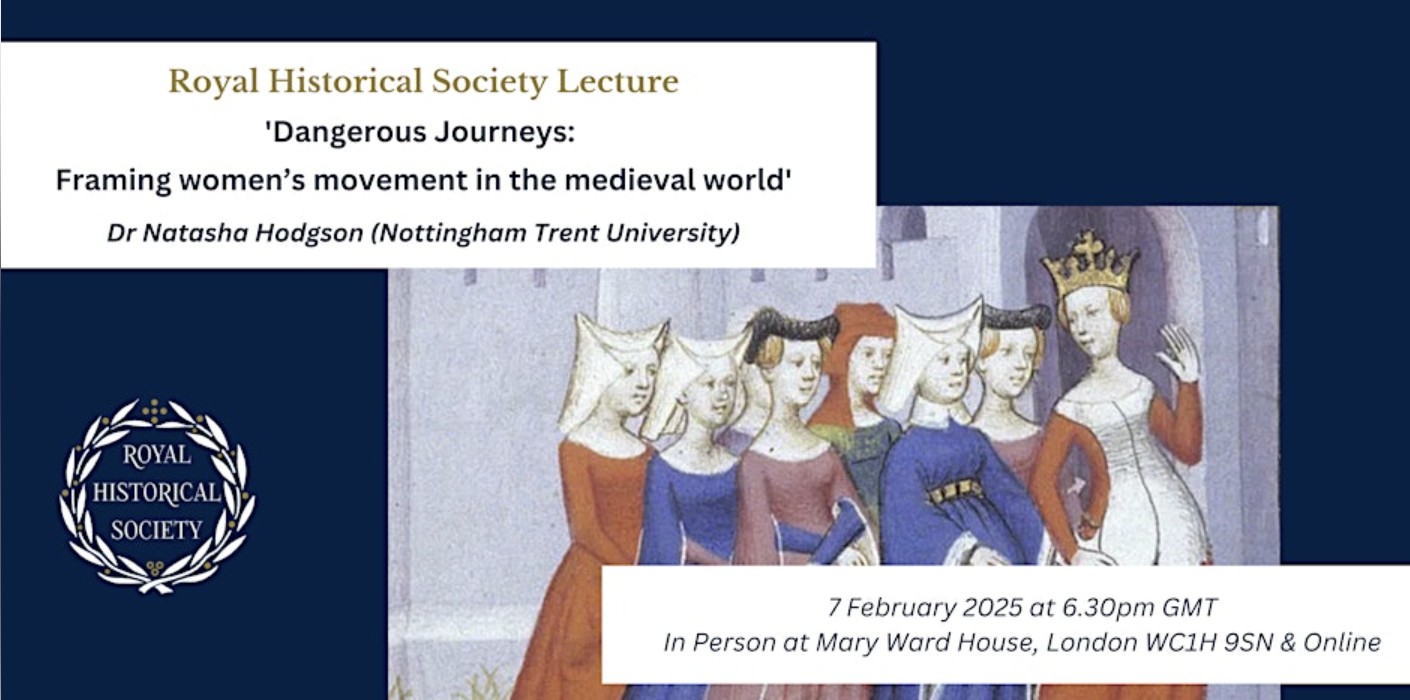
- This event has passed.
Royal Historical Society Lecture: Natasha Hodgson – ‘Dangerous Journeys: Framing Women’s Movement in the Medieval World’
7 February @ 6:30 pm - 8:00 pm

This talk is available to attend in-person or online. For more information, visit the RHS website.
Medieval society is often thought of as static, unchanging, and underdeveloped – yet the period we now call ‘medieval’ represents one thousand years of human history during which seismic changes in ideas, technologies, demography and cultures took place. Similarly, when looking at medieval women, historians have often tended to focus on and reinforce accounts of restrictions on their power and movement, even though their experiences could vary considerably according to social, cultural, economic and geographical factors. Those able to break this mould were considered ‘exceptional’.
Recent scholarship, especially on queenship and female lordship, has successfully challenged this model and argued for a shift in perception of how we view female power to recognise its extent more fully. However, women’s ability to move around the medieval world, and its significance in terms of our understanding of women’s experiences, has not quite yet been subject to the same lens.
Women who left their homes and travelled, whether temporarily or to migrate, are still often viewed as largely exceptional. However, from the eleventh century onwards patterns of movement and migration intensified, governed by local subsistence crises, the growth of urban centres and the search for new trade routes as well as lands to settle.
In the Latin West, pilgrimage and crusade brought further spiritual dimensions to this process, as well as increased visibility and justifications for the women who took part in them. Many faced criticism, or at the very least concerns about the dangers posed to women’s personal and spiritual safety, yet this did not prevent a substantial number of women from all social classes moving around the medieval world.
This lecture argues for an expanded view of women’s movement in medieval society. It will consider how and why women moved through the medieval world in a literal sense, often travelling long distances for social, economic and religious purposes – even after their deaths. It also considers their opportunities for movement, and the extent to which they chose their own paths freely.
Speaker Biography
Dr Natasha Hodgson is an Associate Professor in History and Director of the Centre for Research in History, Heritage and Memory Studies (CRHHMS) at Nottingham Trent University in the UK.
Natasha’s research has focused on medieval and early modern social and cultural history including women, gender and masculinities, as well as encompassing Digital Humanities projects based upon Domesday Book and Fifteenth Century genealogical rolls. Most recently she was a consultant on the British Library exhibition Medieval Women: In Their Own Words and co-founded teachingmedievalwomen.org, a collaborative project between academics and teachers to revitalise and expand the teaching of women’s history in medieval provision at schools (2022-present).
Natasha wrote Women, Crusading and the Holy Land in Historical Narrative (Boydell, 2007), and is a co-editor of Crusading and Masculinities (2019), Religion and Conflict in Medieval and Early Modern Worlds (2020), and Miracles, Political Authority and Violence in Medieval and Early Modern History (2021). She is also an editor of the journal Nottingham Medieval Studies and two Routledge series: Themes in Medieval and Early Modern History and Advances in Crusades Research.